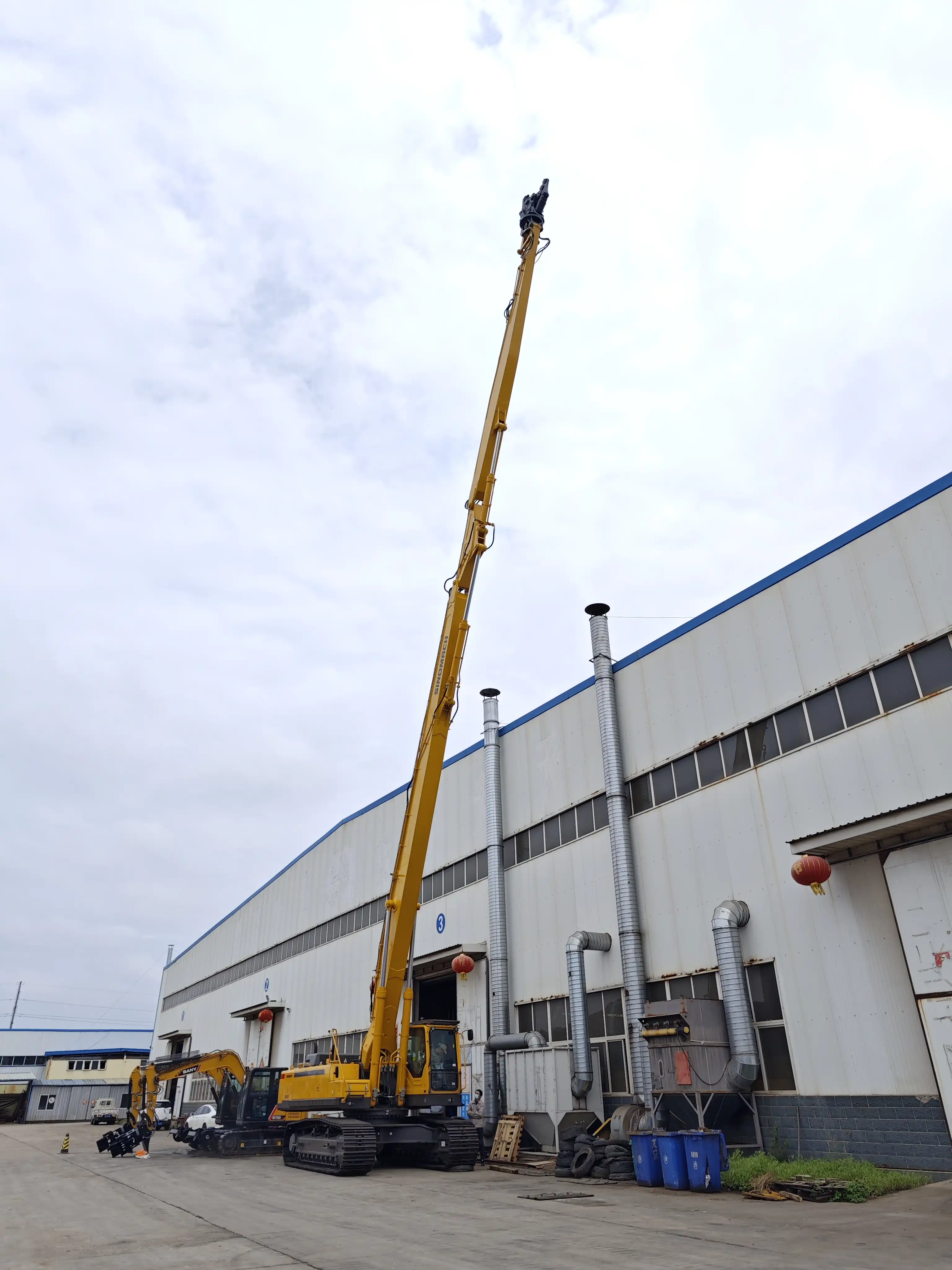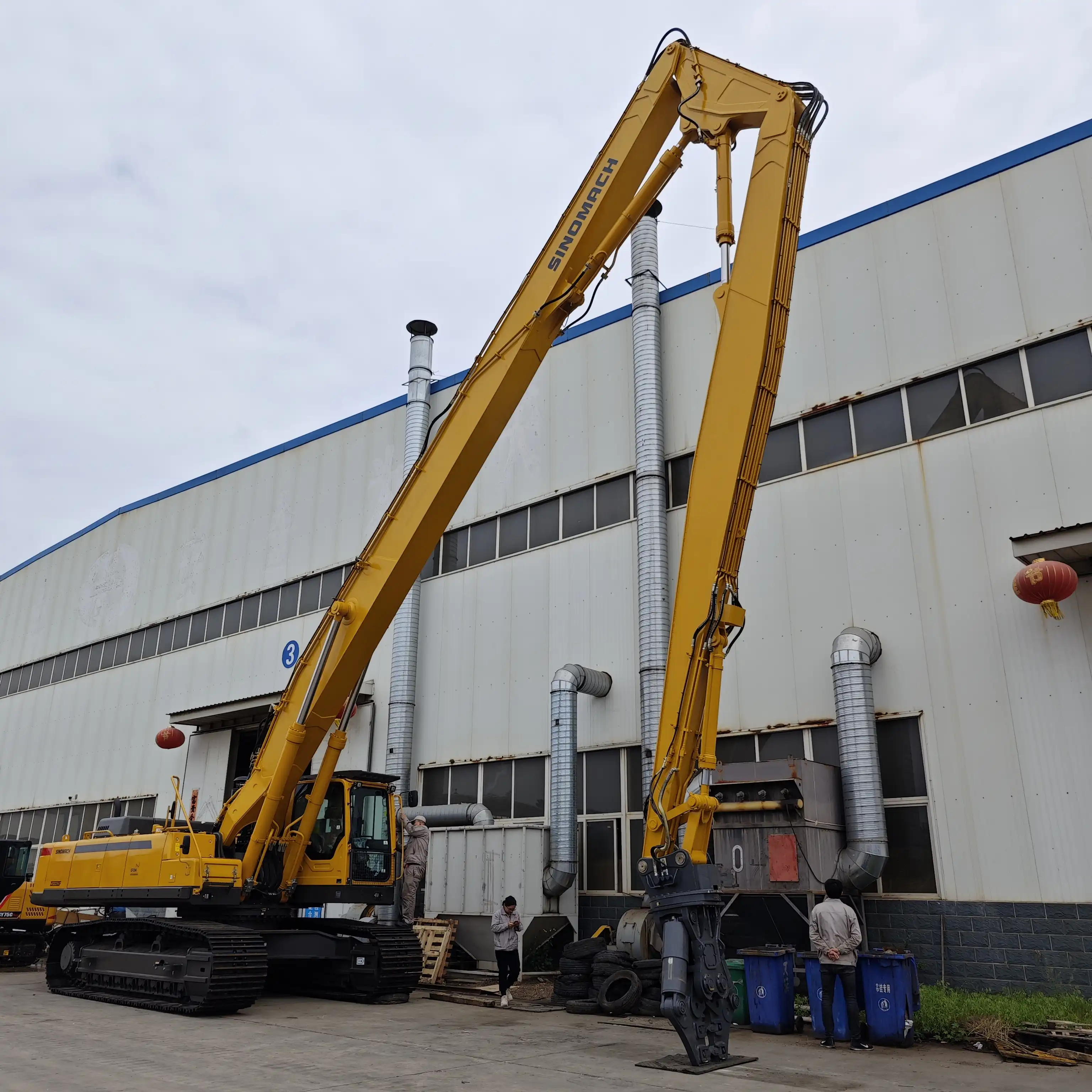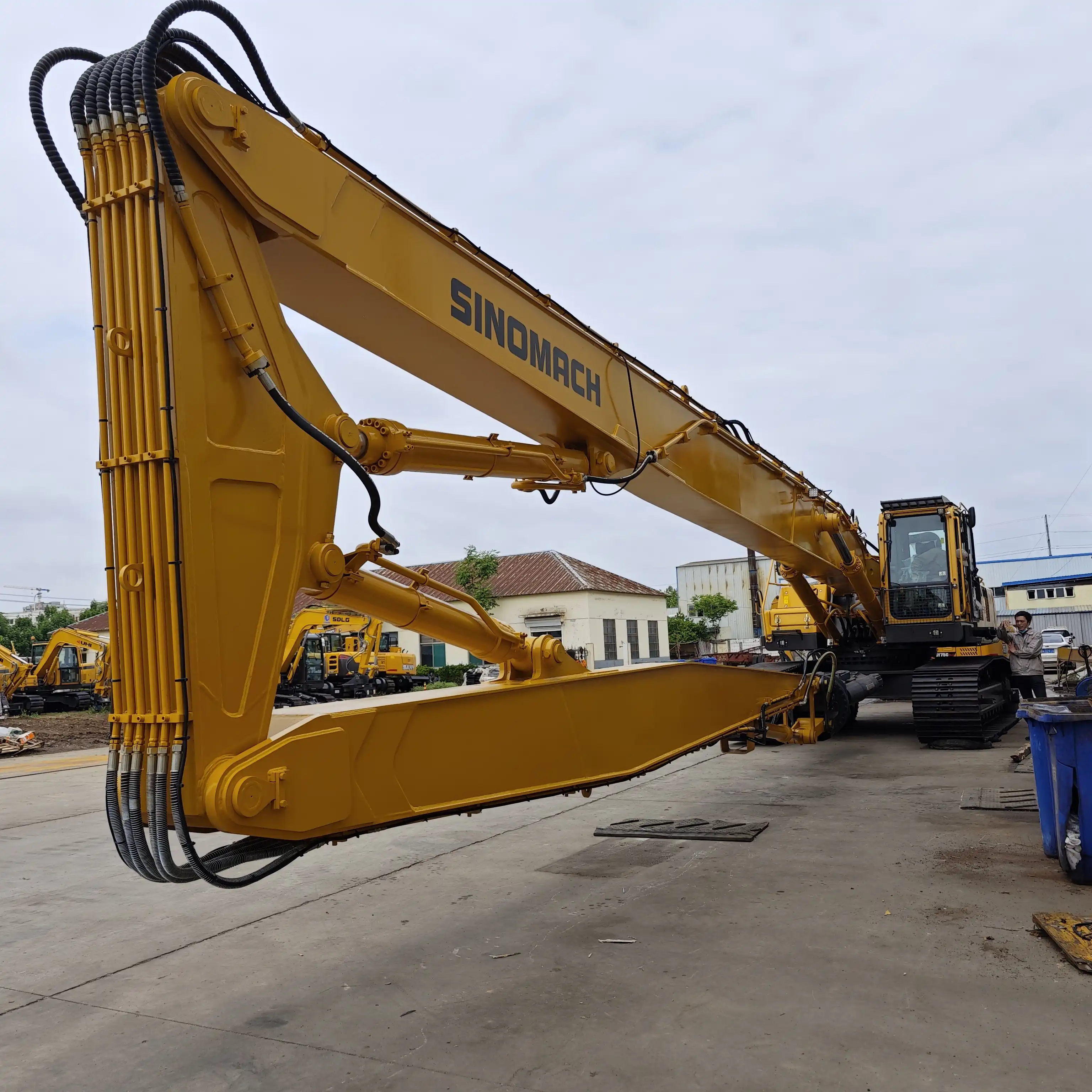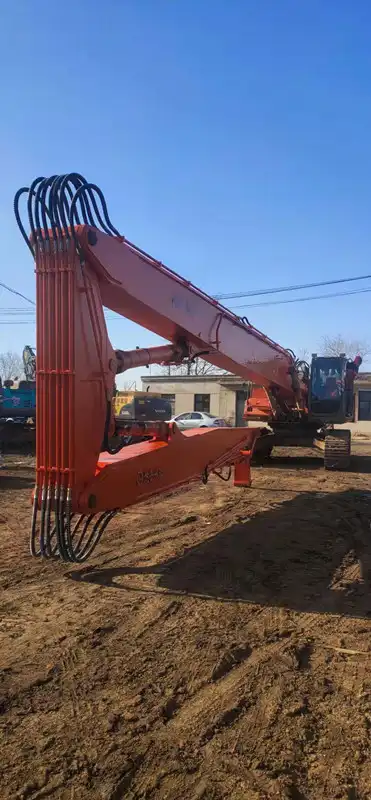What Are the Different Types of Excavator Booms?
Excavator booms are the backbone of versatility in construction and demolition equipment, determining what tasks your machine can accomplish efficiently. Understanding the different types of excavator booms is crucial for selecting the right equipment for your specific project requirements. Excavators come equipped with various boom configurations, each designed for particular applications ranging from standard digging operations to specialized demolition work requiring extended reach. Among these specialized options, the excavator high reach demolition long boom and arm stands out as a crucial attachment for projects demanding exceptional vertical reach and precision control during demolition activities.
The primary categories of excavator booms include standard mono booms for everyday digging tasks, specialized demolition booms for structural dismantling, and long-reach booms for operations requiring extended reach capabilities. Each boom type offers distinct advantages and operational characteristics that make them suitable for specific applications within construction, demolition, railway maintenance, and industrial sectors. The right boom selection can significantly impact your project's efficiency, safety, and overall success, particularly when dealing with challenging environments or specialized tasks.
In this comprehensive guide, we'll explore the various excavator boom configurations available on the market today, examining their unique features, ideal applications, and the benefits they bring to different industrial settings. Whether you're looking to enhance your fleet's capabilities or seeking the perfect attachment for an upcoming specialized project, understanding these boom variations will help you make informed equipment decisions that optimize your operational efficiency and project outcomes.
Standard Mono Boom

The standard mono boom represents the most common excavator attachments found across construction sites worldwide. This traditional single-piece design serves as the industry benchmark for versatility and reliability in everyday excavation tasks.
Design and Construction Features
Standard mono booms feature a solid, one-piece construction with a fixed angle that provides excellent balance between digging depth, height, and reach. These booms are engineered with high-strength steel to withstand intense digging forces while maintaining operational stability. The straightforward design includes reinforced pivot points and precision-machined hydraulic cylinder mounts that ensure consistent performance under varied load conditions.
Most standard booms incorporate an optimized weight-to-strength ratio, enabling maximum bucket capacity utilization without compromising the excavator's stability. The hydraulic systems are integrated directly into the boom structure, with protected routing to minimize vulnerability to damage during operation in harsh environments.
Typical Applications
Standard mono booms excel in conventional excavation work including:
- Trench digging for utility installation and foundation preparation
- General earthmoving and material handling operations
- Loading trucks and clearing construction sites
- Basic landscaping and grading applications
- Railway bed preparation and maintenance tasks
These booms provide the ideal balance of power, reach, and maneuverability for most standard construction projects where extreme height or extended reach isn't required.
Advantages and Limitations
The primary advantages of standard mono booms include:
- Exceptional digging force and breakout power
- Superior stability during heavy lifting operations
- Simplified maintenance requirements due to fewer moving parts
- Greater durability in demanding conditions
- Cost-effective operation for standard excavation tasks
However, these booms do have limitations, particularly when specialized work is required:
- Limited vertical reach compared to specialized configurations
- Restricted working range in confined spaces
- Less adaptability for specialized demolition or precision tasks
- Not suitable for projects requiring extended horizontal reach
Understanding these limitations helps contractors determine when standard booms are sufficient and when specialized options like excavator high reach demolition long boom and arm configurations might be necessary for project-specific requirements.
Demolition Boom

Demolition booms represent specialized excavator attachments engineered specifically for the challenging demands of structural dismantling and demolition projects. Their unique design focuses on providing exceptional reach while maintaining the stability and control necessary for precision work in hazardous environments.
High Reach Demolition Configuration
The excavator high reach demolition long boom and arm configuration stands as the premier solution for projects requiring significant vertical reach. These specialized systems typically feature:
- Multi-section boom designs with additional hydraulic joints
- Reinforced structural components to withstand demolition forces
- Specialized counterweight systems to maintain machine stability
- Advanced hydraulic controls for precise implement positioning
- Integrated safety systems including pressure sensors and automatic shutdown protocols
Modern high reach demolition booms can extend to impressive heights, with top-tier models reaching up to 15 meters or more. This exceptional reach allows operators to safely dismantle structures from a secure distance, minimizing exposure to falling debris and structural collapse risks.
Safety Features and Considerations
Demolition work presents unique hazards that require specific safety features in boom design:
- Operator protective systems including reinforced cabs and falling object protection
- Real-time load monitoring to prevent overextension and tipping
- Quick-release mechanisms for emergency attachment separation
- Enhanced visibility systems including cameras and sensors
- Dust suppression integration capabilities
These safety features work together to protect both equipment and personnel during high-risk demolition operations. The specialized nature of demolition booms requires operators with specific training to maximize both safety and productivity.
Specialized Attachments
Demolition booms are designed to work with a variety of specialized attachments:
- Hydraulic crushers and pulverizers for concrete processing
- Shears for cutting structural steel and reinforcement
- Grapples for controlled material handling and sorting
- Multi-processors that combine multiple demolition functions
- Dust suppression systems that integrate directly with the boom
The versatility provided by these attachments makes demolition booms incredibly valuable for complex project requirements. The ability to quickly switch between different tools without changing the base boom configuration significantly enhances productivity on demolition sites where conditions and material types frequently change.
Long-Reach Boom

Long-reach booms represent specialized excavator configurations designed to extend the working radius well beyond standard equipment capabilities. These purpose-built systems enable operators to access areas otherwise unreachable with conventional excavator setups.
Extended Reach Capabilities
The defining characteristic of long-reach booms is their exceptional horizontal and diagonal reach capabilities:
- Extended boom structures that can reach up to 20 meters or more
- Reinforced arm components to maintain precision at maximum extension
- Special hydraulic systems optimized for smooth control at distance
- Custom counterweights to balance the extended load envelope
- Modified undercarriage designs for enhanced stability
These extended capabilities make long-reach booms invaluable for projects where access is limited or where working at a distance from the machine is necessary for safety or environmental reasons. Unlike standard configurations, long-reach systems prioritize horizontal reach over maximum lifting capacity.
Specialized Applications
Long-reach booms excel in several specialized applications:
- Dredging operations in rivers, lakes, and coastal areas
- Bank and slope maintenance along waterways
- Environmental restoration projects in sensitive areas
- Land reclamation where access is restricted
- Railway maintenance in areas with limited side access
- Mining operations requiring reach across safety barriers
The ability to work effectively from a stable position while accessing difficult areas makes these booms particularly valuable in environmentally sensitive projects where minimizing site disruption is critical.
Customization Options
Modern long-reach booms offer extensive customization options to meet specific project requirements:
- Variable boom section lengths to optimize for specific reach needs
- Adjustable counterweight systems for different operating conditions
- Specialized bucket and attachment mounting systems
- Enhanced hydraulic circuits for attachment versatility
- Reinforcement packages for intensive applications
These customization options allow contractors to precisely match their equipment capabilities to project requirements, optimizing both performance and operational costs. When paired with GPS guidance systems and machine control technology, modern long-reach booms can achieve remarkable precision even at their maximum extension limits.
FAQ
①What is the difference between a dipper arm and a boom on an excavator?
The boom is the main structural component that connects to the excavator body and provides the primary reach, while the dipper arm (or stick) connects to the end of the boom and holds the bucket or attachment. Together, they create the articulated arm system that gives excavators their versatility and range of motion.
②How do I choose the right boom type for my project?
Consider your project's specific requirements including required reach, lifting capacity, and the type of material being handled. Standard booms work well for general excavation, while specialized applications like demolition or dredging may require dedicated boom configurations.
③Can excavator booms be changed or replaced?
While possible, changing an excavator's boom configuration typically requires specialized equipment and expertise. Many contractors opt to rent specialized machines with appropriate boom configurations rather than modifying existing equipment.
④What maintenance is required for excavator booms?
Regular inspection of pins and bushings, hydraulic cylinder maintenance, and structural integrity checks are essential. High-reach demolition booms require additional attention to safety systems and load monitoring equipment.
⑤What safety considerations are important when operating long booms?
Always be aware of the machine's stability envelope, particularly when fully extended. Use outriggers when available, avoid sudden movements, and follow manufacturer guidelines for maximum safe operating weight at various extension points.

Tiannuo Excavator Attachments
Selecting the appropriate excavator boom type is crucial for optimizing efficiency and safety across various construction, demolition, and maintenance applications. Standard mono booms provide reliable performance for everyday excavation tasks, while specialized excavator high reach demolition long boom and arm configurations deliver the extended vertical reach necessary for precision demolition work. Long-reach booms extend your operational capabilities horizontally, making previously inaccessible areas workable without repositioning heavy equipment.
Understanding these distinct boom types and their specific applications helps contractors and project managers make informed equipment decisions that enhance productivity while controlling operational costs. Whether you're involved in railway construction, building demolition, or environmental restoration projects, choosing the right excavator boom configuration can significantly impact your project timeline and bottom line.
For specialized excavator booms including high-reach demolition configurations, long-reach options, or custom solutions tailored to your specific project requirements, contact Tiannuo Construction Machinery Co., Ltd. Our comprehensive range of excavator high reach demolition long boom and arm includes options compatible with all major excavator brands, with lifting capacities up to 30 tons and maximum reach extending to 15 meters. To learn more about our specialized excavator boom solutions, contact us at arm@stnd-machinery.com.
References
Construction Equipment Guide (2023). "Advanced Excavator Boom Technologies for Modern Construction Applications."
Journal of Construction Engineering (2024). "Comparative Analysis of Excavator Boom Types and Their Performance in Demolition Projects."
International Association of Demolition Contractors (2024). "Safety Standards for High-Reach Demolition Equipment Operations."
Engineering News-Record (2023). "Innovations in Hydraulic Systems for Extended Reach Excavator Applications."
Construction Machinery Technology Review (2024). "Material Strength and Structural Design Considerations for Specialized Excavator Booms."
About Author: Arm
Arm is a leading expert in the field of specialized construction and railway maintenance equipment, working at Tiannuo Company.

